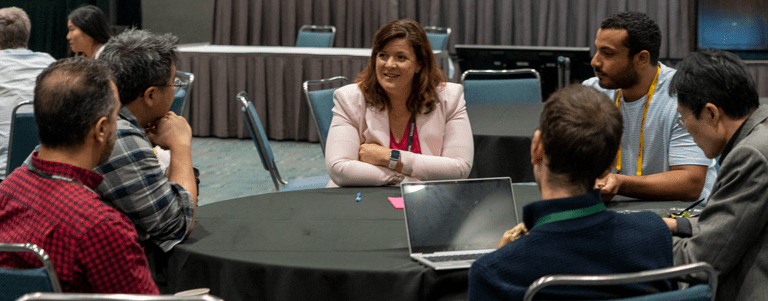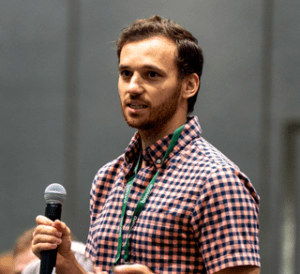By Kiran Musunuru, MD, PhD, MPH, ML

With its first in-person Annual Meeting in three years, the American Society of Human Genetics was able to convene more than 7,000 people in Los Angeles this past October. It was a welcome opportunity to reconnect the global human genetics and genomics community in person after a long time apart. Yet even during the worst of the pandemic, the community had remained incredibly active and engaged in genetics and genomics research—and being together in one place to partake in hundreds of platform, plenary, and invited session talks as well as thousands of posters made it abundantly clear how much progress has been made in the field over the past few years.
Yet despite so many members of our community being able to come together in Los Angeles, not everybody who might have liked to attend was able to, whether because the pandemic has yet to draw to a close, or because of logistical barriers that long predated the pandemic. To engage community members who could not attend in person, the Society launched a new virtual event, the two-day, interactive Genetics and Genomics Digital Forum, that took place three weeks after the in-person Annual Meeting on November 15-16. It featured plenary sessions, poster talks, the Epstein Award winners, virtual workshops, industry thought leadership, themed networking, and on-demand content from the Annual Meeting—in some cases, revisiting and expanding upon some of the most exciting content of the in-person meeting, and in other cases, highlighting fresh new late-breaking science that could not be featured in Los Angeles.
Recognizing the unusual opportunity presented by the relaunching of the in-person Annual Meeting after a lengthy hiatus, and the launching of a brand-new Digital Forum, the ASHG Program Committee organized a number of roundtable discussion sessions to conclude the Annual Meeting. The Saturday event, which closed the meeting, allowed attendees to synthesize and reflect upon all they had seen over the prior week and how it might influence their everyday work going forward. These discussions were mirrored by networking sessions at the Digital Forum, which had similar goals. In total, a few hundred individuals attended these sessions, providing a representative cross-section of the human genetics and genomics community.
So what fired the imagination of our community members who attended the Annual Meeting and Digital Forum? Although it is impossible to convey the full depth and nuance of the conversations here, we have attempted to capture the major themes that came up repeatedly during the discussions. Which of these excites you, and what do you predict will be at the forefront of attention at the ASHG Annual Meeting in 2023 in Washington, DC?
-

ASHG attendee speaking at Saturday Roundtables Event New methods and new guidelines for the classification of variants of uncertain significance. Ranging from increasingly sophisticated computational tools to high-throughput functional assays, new approaches to tackling the problem of variants of uncertain significance being identified in patients undergoing genetic testing are gaining traction. One challenge is figuring out how to best incorporate the information generated by these tools and assays into clinical practice, in ways that maximize benefit and—just as importantly—minimize harm to patients. The announcement of a forthcoming update to variant classification guidelines from a joint ACMG/AMP/CAP/ClinGen group generated significant enthusiasm among practitioners of clinical genetics.
- Equitable application of polygenic risk scores in the clinical setting. Although polygenic risk scores were a hot ticket item three years ago at the ASHG Annual Meeting in Houston, the interest has only intensified since then. Polygenic risk scores are being productively applied not just to complex diseases but to Mendelian diseases and non-disease phenotypes (e.g., protein levels) as well. At the same time, there is widespread appreciation that polygenic risk scores need to account for population diversity before they can be incorporated into patient care. Many participants also highlighted the need for carefully conducted clinical trials incorporating polygenic risk scores along with traditional risk factors for common diseases to assess their efficacy. Investigation as to how to best tailor each polygenic risk score to each given individual is underway.
- Long-read sequencing, optical genome mapping, and other methods to capture genomic complexity. New techniques have become available and scalable to assess genomic DNA samples for increasingly complex types of genetic variation, such as structural variants, tandem repeats, and methylation. There was particular enthusiasm for long-read RNA sequencing, which is allowing for unprecedented analyses of splicing variation and RNA editing.
- Integration of genetic, proteomic, metabolomic, and other types of big data in very large cohorts. Even as recently as the ASHG Annual Meeting in Houston three years ago, reports of very large association studies were largely limited to genetic data. There are now serious efforts underway to integrate additional types of multi-omic data in large-scale studies, particularly with biobank cohorts. Especially when combined with phenotypic and environmental exposure data, these studies are offering important new clues into biological pathways and mechanisms.
- New models and new assays to follow up the results of association studies and understand disease mechanisms. Even as association analyses grow increasingly larger and multi-dimensional, the work of mechanistically linking the identified variants to genes and to mechanisms remains challenging. The development and refinement of new approaches—ranging from massively parallel assays of various kinds to increasingly sophisticated analyses in animal models such as mice, zebrafish, flies, and worms—are accelerating efforts to discover new biology.
- Diversity, equity, and inclusion in human genetic and genomic studies. Concerns about the need to improve DEI in research—both with respect to research participants as well as the researchers themselves—remained front and center. The Presidential Symposium and plenary talks on the progress of genetic studies involving African populations and Australian indigenous communities received a lot of attention, as did discussions about community engagement. There was also recognition of inequities in the past in the genetics field, which manifested in different ways including ancestry and sex, cell line origins, and reference genomes available for analyses
